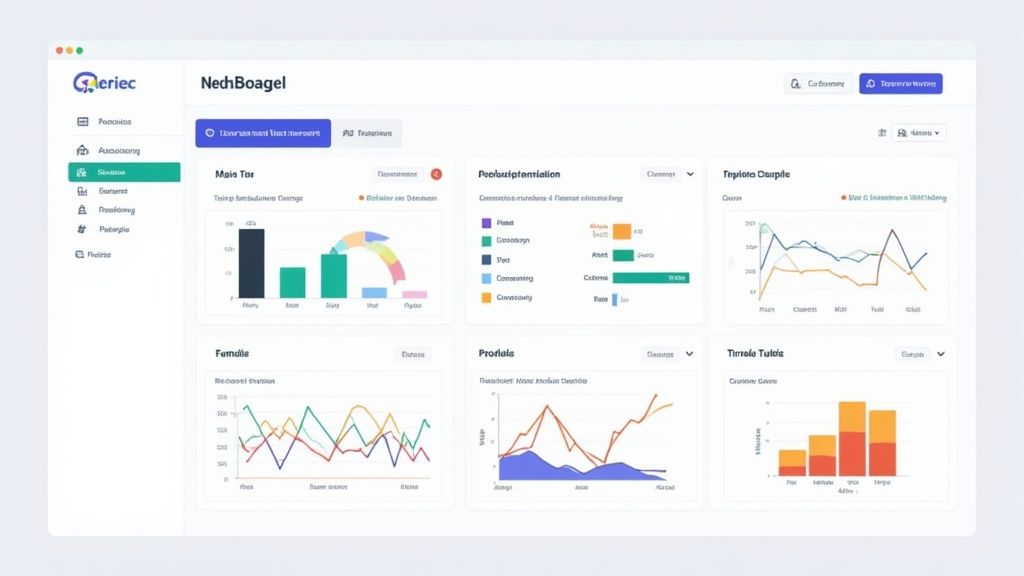Resource Allocation Optimization: A Strategic Guide to Maximizing Efficiency
Transform your resource management with data-driven optimization strategies that deliver measurable results. Learn battle-tested approaches from organizations that have mastered the art of strategic resource allocation. meta t: Resource Allocation Optimization: A Strategic Guide to Maximizing Efficiency published: No slug: resource-allocation-optimization
Understanding Data-Driven Resource Allocation

Smart companies are moving away from making decisions based on hunches. Instead, they're using real data to guide how they distribute their resources. This approach helps them spot what's working, what isn't, and where they can make improvements. The goal is simple: get the best possible results from every resource they put to use.
Identifying Key Data Signals
To make smart choices about resources, you need to watch the right signals. Here are the main types of data that matter:
Project Performance Data: Look at how quickly projects finish, whether they stay on budget, and their success rates. This shows which projects are using resources well and which ones might need changes.
Team Capacity & Utilization: Track how teams spend their time to spot who's overworked and who has room to take on more. This helps prevent burnout while making sure everyone's skills are put to good use.
Financial Data: Keep close watch on costs to understand the money side of resource decisions. This helps link spending choices to actual business results.
Operational Data: Watch numbers like production output and customer feedback to see how resource choices affect real business outcomes.
Analyzing Current Allocation Patterns
The next step is to look closely at how resources are being used right now. This means checking which teams and projects get what resources. Simple charts and graphs can help spot patterns - like areas that have too many resources or not enough. This creates a starting point to measure future improvements against.
Looking at past data helps reveal what's worked before and what hasn't. This insight is key for making better choices going forward. Teams can use this information to spread work more evenly and work together more smoothly. For more details about making resource decisions based on data, check out this article on resource allocation and operations intelligence.
Implementing Data-Informed Improvements
Once you understand what the data is telling you, it's time to make changes. This might include:
Moving resources away from struggling projects to more successful ones
Changing team structures to balance workloads better
Offering training to build up team skills
Adding new tools to handle routine tasks automatically
Make these changes step by step, and watch carefully to see how they work out.
Measuring the Impact of Changes
The final piece is tracking how well the changes work. Keep watching key numbers and compare them to where you started. This creates a feedback loop that helps fine-tune resource decisions over time. By sticking to what the data shows, organizations can spot and fix problems before they become serious, setting themselves up for long-term success.
Measuring Success Through Optimization Metrics
Successful resource allocation requires both smart planning and measuring results. By tracking the right metrics, you can see if your strategies work and where they need adjustment. Good measurement helps you make better decisions about how to use your resources.
Identifying the Right KPIs for Resource Allocation Optimization
Every organization needs to choose metrics that match their goals. Here are key metrics to consider:
Resource Utilization Rate: Shows what percentage of your resources are actively in use. While high utilization can signal efficiency, be careful not to overwork your teams.
Project Success Rate: Measures how many projects finish on time and within budget. Higher rates often mean you've allocated resources well.
Cost Efficiency: Looks at resource costs per output unit. Lower costs typically mean better resource use.
Return on Investment (ROPI): Shows the money earned compared to resources invested. A good ROI means resources are going to profitable work.
Building a Metrics Framework
To track progress well, you need a clear framework:
Set Clear Goals: Define what you want to achieve. For example: "Cut project completion time by 15%"
Pick Relevant Metrics: Choose metrics that connect to your goals. If you want faster projects, track completion times
Plan Data Collection: Decide how to gather metric data using tools like Microsoft Project or time trackers
Create Reports: Choose how to share insights with your team. Simple dashboards often work best
Metrics help show if your resource plans work well. For example, a factory can use metrics to see which production lines need more support. This helps them move resources where needed to boost output and cut costs. Read more about optimization metrics here.
Avoiding Common Measurement Pitfalls
Watch out for these common mistakes:
Skip Surface-Level Numbers: Don't focus on metrics that look good but don't help reach goals. Task counts matter less than actual progress
Include Team Feedback: Numbers tell only part of the story - listen to your team's experiences too
Check Metrics Often: Review regularly to spot trends and fix issues early
Creating Actionable Insights from Optimization Metrics
Data only helps when you use it well:
Review Regularly: Set up weekly or monthly metric reviews
Find Patterns: Look for connections between resource decisions and results
Make Changes: Use what you learn to improve your resource planning
By tracking clear metrics, reviewing them often, and making changes based on data, you can keep improving how you use resources. This ongoing process helps boost efficiency and reach better results over time.
Using Predictive Analytics for Future Planning

Smart organizations are moving beyond just reacting to resource problems as they happen. By using predictive analytics, they can spot potential issues before they impact projects and allocate resources more effectively. Let's look at how these prediction models work in real situations.
Building Prediction Models for Better Resource Planning
Creating useful prediction models starts with good data. Historical information about past projects, resource usage patterns, and market factors provides the foundation for making accurate forecasts. For instance, a software company might notice they consistently need more developers during testing phases - this insight helps plan future staffing. The right analysis tools are also key for processing large datasets and generating reliable predictions.
The next phase involves building the actual forecasting model. This requires analyzing patterns in the data to find meaningful relationships. A model might discover, for example, that more complex projects need proportionally more designers. But these models need regular updates - as new information comes in or business requirements shift, the models must adapt.
Prediction tools show their value in many real scenarios. Take emergency services - by forecasting where emergencies are likely to occur, teams can position ambulances and staff in advance. Studies show this approach reduces response times by at least 10% and enables quick adjustments when needed. Learn more about emergency response prediction systems here. This proactive planning leads to better outcomes and can save lives, showing the real impact of smart resource planning.
Solving Common Implementation Issues
Setting up predictive systems comes with some hurdles. Data quality is essential - poor or missing data leads to unreliable predictions. The models themselves can also be tricky. If they're too complex, teams struggle to understand and use them effectively. This makes choosing appropriate software and bringing in the right expertise crucial.
Sometimes staff members resist new systems. People used to traditional planning methods may hesitate to try new approaches. Clear communication about benefits, proper training, and sharing success stories helps build acceptance. When teams see real improvements from using predictions, they're more likely to embrace data-driven planning. Regular testing and fine-tuning of the models ensures they stay accurate and useful. This ongoing process helps organizations adapt to changes while getting the most value from their resources.
Case Study: Public Sector Implementation
Resource allocation is critical for public sector organizations. These organizations deal with specific limits like fixed budgets, complex procedures, and constant public oversight. Still, by applying smart resource allocation methods, they can deliver better services and build stronger community relationships.
Overcoming Public Sector Hurdles
Getting resource allocation systems working in government settings takes careful planning. Departments often compete for resources and have different goals, which makes teamwork tricky. Administrative procedures can also delay changes. The key is showing clear benefits - like reducing costs and improving services - to get everyone on board.
Using Data to Guide Decisions
Numbers and facts should drive resource choices in government, just like in business. By studying service demands, population data, and operating expenses, agencies can spot ways to work better. For instance, tracking emergency call patterns helps set the right staffing levels at different times. This fact-based approach leads to smarter resource use.
A Historic Look at Police Resource Planning
Police departments were early adopters of resource planning techniques. In February 1968, the Chicago Police Department started a research project to improve how they used their resources. They looked at staff deployment, equipment use, and patrol strategies like equal police coverage and focusing on high-crime areas. Learn more about this pioneering effort here.
Tracking Real Progress
Public agencies need to measure their results. Setting clear performance targets helps track improvements and show accountability. Key measures might include:
Emergency response speed
Public satisfaction scores
Operating cost reductions
Success Stories in Action
Many public organizations have improved their resource use significantly. For example:
Cities using smart traffic systems that adjust signals based on real-time traffic
Agencies offering online permit applications to speed up processing
Emergency services optimizing vehicle and staff locations
These examples show how better resource planning directly improves public services. The keys to success are using solid data, working together across departments, and focusing on measurable improvements that matter to citizens.
Implementing Dynamic Resource Allocation Strategies

Smart resource allocation helps organizations quickly adapt to changing project needs while maintaining efficiency. This approach enables teams to shift resources where and when they're needed most, rather than being locked into rigid plans.
Building Flexible Allocation Frameworks
A good resource allocation system needs to bend without breaking. Project needs often change - a software project might suddenly need more testers, or a marketing campaign could require extra designers at key stages.
To make this work, you need clear communication channels so team leads can quickly request resources when needed. It's also helpful to maintain a mix of internal staff and external contractors who can step in when workload spikes.
Monitoring and Adjustment in Real-Time
Success depends on watching the right metrics. Track things like resource usage, project progress, and budget status through simple dashboards and automated reports. This helps catch issues early.
If you spot a project falling behind because of resource bottlenecks, you can quickly move people from less urgent tasks or bring in extra help. Quick responses help keep projects on schedule.
Developing Agile Resource Management Systems
The key is giving teams more control over their resources. Set clear guidelines for requesting and approving resources, then trust teams to make smart decisions based on their immediate needs.
A central platform for resource requests can speed things up. For example, Citrix Autoscale automatically adjusts virtual resources based on actual usage, helping control costs while meeting user needs.
Implementing Dynamic Allocation Processes
Here's what you need for effective resource allocation:
Resource Tracking: Use project management tools to see who's available and how resources are being used
Flexible Resource Pool: Keep a mix of people ready to help different projects
Clear Communication: Make it easy for teams to request and receive resources
Regular Reviews: Check how well your resource decisions are working and adjust as needed
Building Team Capabilities for Dynamic Allocation
Teams need proper training to make this work. Show them how to use the new systems and processes effectively. More importantly, build a culture where people work well together across different groups and speak up about resource needs.
When done right, dynamic resource allocation helps organizations handle complex projects and changing conditions more smoothly. It's about being ready to adapt while keeping projects running efficiently.
Future Trends and Implementation Roadmap

Resource allocation practices keep changing as new tools and approaches emerge. Let's explore what's coming next and how organizations can prepare for these changes through practical implementation steps.
What's New in Resource Allocation
Here are the key developments shaping how organizations manage their resources:
Smart Automation: Tools now handle routine scheduling and resource assignments automatically. This frees up managers to focus on strategy and complex decisions that need human judgment.
Instant Adjustments: Modern systems like Citrix Autoscale can quickly shift resources based on real-time needs - whether it's project changes or equipment availability.
AI-Powered Planning: Machine learning helps predict what resources you'll need and suggests better ways to use them. The results? More accurate planning and less waste.
Employee Care: Companies now look beyond just efficiency. They consider things like balanced workloads and skill development when assigning work.
Your Step-by-Step Implementation Plan
Here's how to put these new approaches into practice:
Months 0-3: Review & Plan
Check current resource management methods
Find areas that need improvement
Set clear goals
Choose metrics to track progress
Months 3-6: Pick & Set Up Tools
Research resource management software options
Install and configure chosen tools
Train your team on new systems
Months 6-9: Test & Adjust
Try new processes with a small team first
Get feedback and make improvements
Fix any issues before full rollout
Months 9-12: Full Launch
Roll out across the organization
Keep tracking results
Make ongoing improvements
How to Measure Success
Track these key metrics to see if your changes are working:
Resource Usage: How efficiently are you using available resources?
Project Success: What percentage of projects finish on time and within budget?
Team Happiness: Are employees satisfied with their workloads and assignments?
Cost Benefits: How much money are you saving through better resource use?
Moving Forward with Resource Management
The best approach is to stay flexible and open to new tools while following your implementation plan. This helps you use resources more efficiently, complete projects successfully, and keep your team happy.
Want to improve how you manage resources? Obsibrain offers tools to organize work, manage tasks, and boost productivity. Check out how it can help your team work better together.
Last updated
Was this helpful?